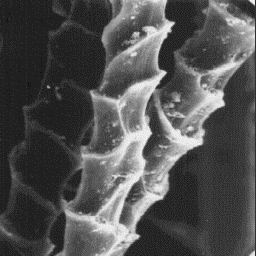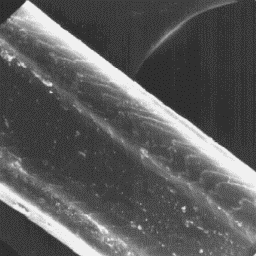 Lemmus lemmus
Lemmus lemmus
-------------
English: Norway lemming
German: Bergleming
French: Lemming des toundras
Spanish: Conejo de norwega
Distribution areas
------------------
The Norway lemming is found in the
wooded areas of North Europe, mainly in
Scandinavia.
Description of the fur
----------------------
The skins of lemmings are from 12 to 14 The cuticular structure
cm long. The hair coat is yellow-brown with of the fine fibres, 2000x
dark spots. Along the back are two yellow
stripes; the belly and the inside parts of the legs are a sand-yellow colour.
The undercoat layer is dark-grey in colour over the whole body. The hairs are
straight and up to 12 mm long.
|
|
 Lemmus lemmus
Lemmus lemmus
-------------
English: Norway lemming
German: Bergleming
French: Lemming des toundras
Spanish: Conejo de norwega
Structure of the hair
---------------------
The microscopic structure of the skin
surface is usually furrowed; the hair
follicles are narrow with straight edges.
The follicles contain clusters of hairs.
The fine fur fibres have a diameter of 8
to 16 µm. Their cross-section is circular The cuticular structure
at the bottom, and straight-sided in the of the fine fibres, 2000x
upper part, of the shaft. The cuticular
scales are of the raised edge-shaped type of the non-regular petal-like shape
with a non-regular grooved surface and straight scale margins. The medulla is
wide, unbroken longitudinally, and is of the uniserial ladder type. The
medullary column is situated in the central axial part of the shaft
symmetrically. The infilling substance in the medullary column has a granular
detailed structure.
|
|
 Lemmus lemmus
Lemmus lemmus
-------------
English: Norway lemming
German: Bergleming
French: Lemming des toundras
Spanish: Conejo de norwega
The intermediate fibres are circular and
elliptical in cross-section, with a
diameter of 20 to 35 µm. The cuticular
scales are of the non-regular petal-like
shape with a smooth scale surface and
straight scale margins. The medullary
column is wide, unbroken and central
symmetrical-shaped in cross-section. The
overall structure of the medulla is of the The cuticular structure
uniserial ladder type. The infilling of an intermediate hair, 1000x
substance has an amorphous detailed
structure.
The guard hairs are elliptical or dumb-bell-shaped in cross-section with a
diameter of from 20 to 65 µm. The cuticle is covered by even, tile-like and
by chevron-like scales with a smooth surface and straight, or sometimes
crenated, margins. The medulla is wide, unbroken, central symmetrical-shaped
in cross-section and is of the fractured uniserial ladder type with and
amorphous detailed structure of the infilling material in the medullary
column.
|
|
 Lemmus lemmus
Lemmus lemmus
-------------
English: Norway lemming
German: Bergleming
French: Lemming des toundras
Spanish: Conejo de norwega
The cuticular structure
of a guard hair, 1000x
|
|
 Lemmus lemmus
Lemmus lemmus
-------------
English: Norway lemming
German: Bergleming
French: Lemming des toundras
Spanish: Conejo de norwega
Transverse section
of a guard hair, 1000x
Numerical code for norway lemming skin structure
------------------------------------------------
Surface of the skin: 3-4-3
Fine fur fibres: 6.1-9.13-3-1-2-1-1-1-6-8.16-5.8
Intermediate fibres: 2.1-13-1-1-2-1-1-1-8-14.25-7.11
Guard hairs: 2.8-8.2-1-1.2-2-1-1-3-8-20.65-7.12
|




